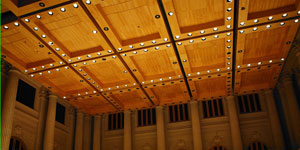The “movable slab”
ceiling concept is important, but it isn’t everything. The acoustic
quality of Sala São Paulo exists in a delicate universe of almost
intangible details, rarely noticed outright, but upon which depend the
quality of the hall’s musical experience. The movable ceiling alone does
not constitute the acoustic quality of Sala São Paulo, nor would it in
any other concert hall. It is a very important aspect in the room and it
will remain a hallmark of Sala São Paulo, but it doesn’t make the half
of it.
Many of the famous halls venerated by musicians, conductors and lovers of symphonic music do not have a movable ceiling or any other tool available to adjust the acoustics. Although its use dates back to the 1960s, adjustable acoustics gained notoriety in the construction of new halls during the past thirty years, thanks to the efforts of great masters of acoustic design such as Kirkegaard, Jaffe, Tanaka and Johnson. The geometry of the room, the position of the balconies, the design of the front of the balconies, the position of the stage, the existence of carpets and curtains (or lack thereof), the thickness of the wood of which the stage is made, the design of the concert seats (upholstered or not), heavy walls, and the irregularities of the building's preexisting architecture make up an important list of contributions absolutely fundamental to the quality of its acoustic climate. If the Sala São Paulo had the right movable ceiling, but all of the other elements were incorrect, the acoustic quality would be greatly inferior. However, if the room had a fixed ceiling, with the correct height, and all of the other elements were in place, it would be less versatile, the existing architecture would be less aesthetically appreciated, but regardless, it would have the potential to be acoustically excellent.
ACOUSTICS

The Acoustic Project
By José Augusto Nepomuceno
The “movable slab” ceiling concept is important, but it isn’t everything. The acoustic quality of Sala São Paulo exists in a delicate universe of almost intangible details, rarely noticed outright, but upon which depend the quality of the hall’s musical experience. The movable ceiling alone does not constitute the acoustic quality of Sala São Paulo, nor would it in any other concert hall. It is a very important aspect in the room and it will remain a hallmark of Sala São Paulo, but it doesn’t make the half of it.
Many of the famous halls venerated by musicians, conductors and lovers of symphonic music do not have a movable ceiling or any other tool available to adjust the acoustics. Although its use dates back to the 1960s, adjustable acoustics gained notoriety in the construction of new halls during the past thirty years, thanks to the efforts of great masters of acoustic design such as Kirkegaard, Jaffe, Tanaka and Johnson. The geometry of the room, the position of the balconies, the design of the front of the balconies, the position of the stage, the existence of carpets and curtains (or lack thereof), the thickness of the wood of which the stage is made, the design of the concert seats (upholstered or not), heavy walls, and the irregularities of the building's preexisting architecture make up an important list of contributions absolutely fundamental to the quality of its acoustic climate. If the Sala São Paulo had the right movable ceiling, but all of the other elements were incorrect, the acoustic quality would be greatly inferior. However, if the room had a fixed ceiling, with the correct height, and all of the other elements were in place, it would be less versatile, the existing architecture would be less aesthetically appreciated, but regardless, it would have the potential to be acoustically excellent.
Then why the moveable ceiling? For what reason do the acoustics of the room need to be adjusted?
The goal of concert halls, principally in the second half of the 20th century, has been to adequately attend to a wide array of symphonic repertoire. While it is possible to construct a successful concert hall with a ‘fixed acoustic signature’ and unique size, the state-of-the-art halls in our field are the concert halls that can be altered in a way to attend to the acoustic demands of different performances. These variations can be obtained via electronic amplification or by changing the architecture of the hall. To turn Sala São Paulo into the world-class hall we wished it to be, it would require a state-of-the-art project. To guarantee this acoustic flexibility, a completely movable ceiling was proposed, which would make possible a change in the volume of the room by lowering or raising the ceiling height. The power and characteristics of the reverberation of the space can be adjusted by employing velvet banners, which are rolled and unrolled with mechanism in the catwalk. Such banners, by being above the movable cover, aren’t seen by the listeners, but their presence is certainly heard.
SALA SÃO PAULO NO STREET
VIEW DO GOOGLE MAPS
VIEW DO GOOGLE MAPS
fonte: @edisonmariotti #edisonmariotti http://www.salasaopaulo.art.br





Nenhum comentário:
Postar um comentário